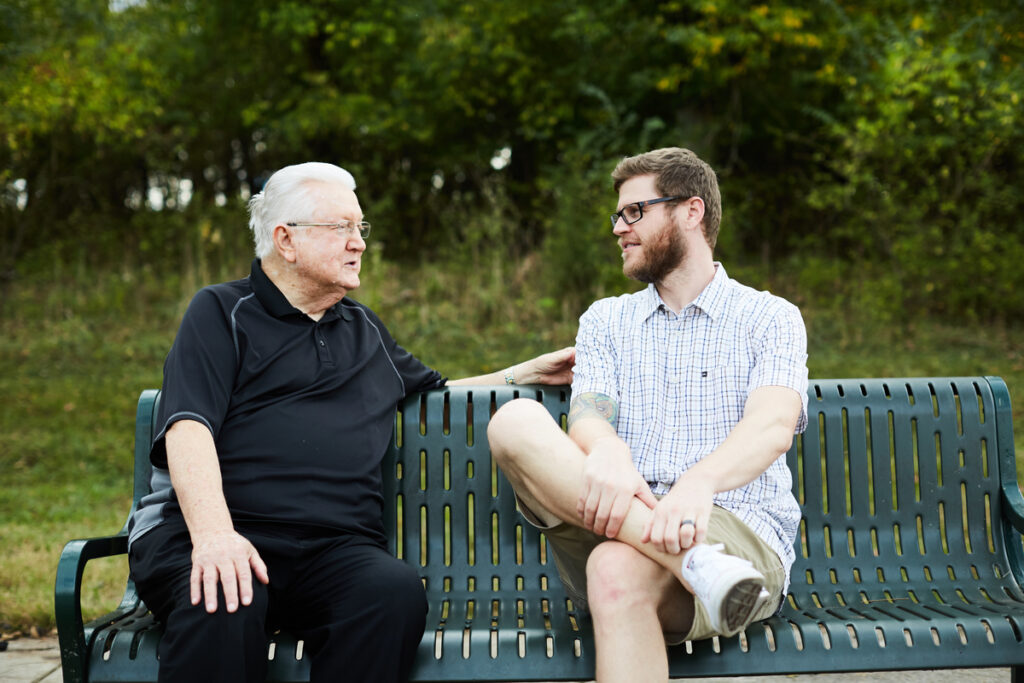“I don’t know man, even if you showed me a YouTube video of Jesus’s resurrection, I’m not sure I would believe it.”
Something along those lines was said to me during my 8 years serving in college ministry. At such a juncture, what do you say? It doesn’t matter how much this person reads C. S. Lewis, Alvin Plantinga, or watches that YouTube debate you send them, they simply do not believe and seemingly will not believe even if the evidence is right in front of them.
This season of ministry in my twenties forced me to take a step back. It’s not always terribly important to know just what the other side thinks, if only the purpose is to win them to your point of view. It’s not even always important to know why people believe what they believe, if that “why,” is just to meant to be plugged into your apologetic formula. In this situation, variable A [they weren’t taught the Bible well] + variable B [they are now at a secular liberal arts school] = they don’t know Jesus and they need to hear my gospel presentation.
Anyone who’s done the slightest bit of extended relational evangelism realizes this. People are complex. Reasons for belief and unbelief are therefore dramatically complex. The danger here though for the minister is it feels like our apologetic must correspond with that complexity. We feel we need to not only be a minister of the gospel, but also contemporary theologian, counselor, life coach, historian, cultural anthropologist, all in one, all while just trying to be a good friend and provide community for people moving fast through a lonely world.
Rather than the whats and the whys of belief, it may be more helpful to consider the “how.” How can one come to say that they can no longer believe the faith of their childhood–even if they literally saw a burning bush or Jesus rise from the dead with their own eyes? What cultural institutions and societal narratives about what it means to be human are driving those conclusions?
In recent years much ink has been spilled trying to explain how the modern world has come to believe what it believes. Charles Taylor’s, A Secular Age (2007) and Andrew Wilson’s Remaking the World (2023), are some of the most recent popular examples of Christian leaders trying to provide a lay-level intellectual history of the Western world.
I would enter into this discussion Josh Chatraw and Jack Carson’s recent work Surprised by Doubt: How Disillusionment Can Invite Us Into Deeper Faith (2023). However, Chatraw and Carson’s approach to answering the “how” question is a bit different. Surprised by Doubt is not an intellectual history, nor is it a pastoral application of Charles Taylor (however, there are aspects of both in the book). Their approach is architectural. Which may seem at first glance a little, well, odd. Many times in these discussions we want to jump to arguments, syllogisms, and conclusions, not housing infrastructure. However, Chatraw and Carson, are not so much detailing an intellectual history, but unpacking the cultural foundations many bring to the process popularly known as “deconstruction.”
They detail for the reader an analogy which shapes the thrust of the book. Many people find themselves struggling with belief. From the belief they have inherited (or have been told they must inherit), they feel boxed in, the air is stale, and life seems gray, if not outright dark and despairing. It seems the whole Christian house is a scam, anti-intellectual, and more motivated by political power than human flourishing. What Chatraw and Carson point out is this framework is not the entirety of the Christian house–but rather an attic within the house.
If you’re getting lost in the sauce of the metaphor, consider a more popular example. Think of Harry Potter under the cupboard of Number 4 Privet Drive. Not quite the attic, but it’s tight, uncomfortable, and oppressive. For many, this is what a life of Christian faith feels like.
What one is prone to do, like Harry, is to flee. To jump out of the window to something, anything else. However, what one finds is that often there isn’t a Ford Anglia outside the window waiting to take you to some distant castle of adventure and joy. Sure, sometimes the leap is exhilaratingly freeing. But what goes up, must come down. Jumping out of a window will end with landing somewhere. And sometimes that “somewhere” is colder, harder, and more jagged than it looked from up in the attic.
If leaving the house is an option on the table for you, rather than jump out of the house, shouldn’t we at least walk downstairs and get a clearer view of the house, foundations, kitchen, living room, foyer, and all, before abandoning it altogether?
The challenge for many is that we often don’t recognize the attic for what it is. And many leading voices within the attic surely don’t either. As our authors communicate, “attic builders too often decenter the attic from the historic essentials by other rooms and set up their theological distinctives as load bearing walls.” Within “attic Christianity” affirming a certain view of Christ’s Millennial reign is more important than affirming the Nicene Creed, rapture theology is spoken of more than the Trinity, and contemporary partisan politics has more implications for how you live than the resurrection of Jesus from the dead.
The rest of the book is a further parsing out of that mental image. They begin by first considering archetypal voices from outside of the house. Other voices, alluring the listening ear away from the attic. Biologist Richard Dawkins, biblical scholar Bart Ehrman, youtuber Rhett McLaughlin (of Rhett & Link), and psychologist Jordan Peterson, are representatives of general trends for those seeking to hear a challenge to their attic Chrisitanity. From my own reading, I thought this was one of the more helpful sections of the entire book. Not because the authors attempt apologetic takedowns of their perceived enemy, but because they are able to recognize why these voices have such an allure for people living in a secular age. Chatraw, borrowing from his approach in Telling a Better Story (2020), shows us again what these approaches seek to tap into, and where they borrow from the Christian story of justice, love, and human dignity. Claiming to be distancing themselves from Christian orthodoxy, these frameworks only create their own “isms,” and fail to deliver on their claims. In fact, often these frameworks only create new attics to be stifled by, leading to an endless loop of deconstruction.
In contrast with these archetypes, throughout the book Chatraw and Carson present us with three examples of historic Christian figures who left their own attics and discovered the rest of the house. Ranging from ancient North Africa, to early modern France, to 20th century Britain, Augustine of Hippo, Blaise Pascal, and C.S. Lewis present to us three examples of men who engaged in a type of deconstruction in their own time, only to be won over by the entirety of the house of the Christian tradition. We may be prone to believe that by virtue of living in the 21st century, the resources for deconstructing an ancient religion are greater and more plausible than ever before. That may be true if the only way to be human and to grow and change is through our minds and intellectual development. What these three figures show is that choosing to have or not have faith is much more than cognitive assent. We are emotional beings as much as we are rational beings, and often our modern debates neglect what Pascal calls, “the logic of the heart.” By reading these former attic Christians from across time we learn more about our own doubts, and how tied they are to our deepest longings. We aren’t the first people ever to have concerns about the faith and to feel stuffed in the attic. What these voices can show us is that there is a way to encounter Jesus that is intellectually viable, emotionally sustainable, and joy-filled.
Since becoming a pastor, I don’t get to have as many conversations as I used to on the college campus. Rather than daily walking through a student’s questions, I’m helping someone process their grief, working alongside our staff to plan for events, and preparing to deliver a Sunday message. I miss the crucible that was the daily grind of engaging with these questions and seeing the light of the gospel begin to click for someone. For all the joys that come with church-specific ministry, one can miss the beauty of daily evangelistic ministry. In these places, we hear the concerns of a watching, lost, and lonely world. We hear where the world feels the church has failed them and failed to provide a vision for their life. If we aren’t careful, we in the church can become so disconnected from that world, that we alienate those we are called to love and persuade to know and love Jesus. We begin to tilt at windmills and create insular conversations and debates disconnected from the world we are trying to reach.
One of the abundantly clear apologetic resources the minister will gain from reading Surprised by Doubt is a chance to re-enter that world. Chatraw and Carson have clearly walked amongst people who regularly wrestle with these questions, and they seek to ask the questions their friends are asking and enter into them with grace and wisdom. They help restore an approach to orthodox, historic Christianity that skeptics or deconstructionists will find to be capacious and life-giving.
By no means would they deny that the gate is narrow, and the way is hard that leads to eternal life. There are indeed, “load-bearing walls” that, as they say, “wherever there are Christians, we find these beliefs.” When these are surrendered, we lose the house altogether. But that does not mean that the Christian tradition over the past 2,000 years doesn’t have the resources to speak to modern concerns. It very much does and does so in a much more emotionally profound way than any other option we try to find.
I say all that to say, I wish I had this book to give to my disbelieving YouTube friend nearly 10 years ago. It wouldn’t have answered every question he had. But it would have been able to help him categorize his own unbelief in a charitable way, while also expanding his horizons for what Christianity is and can be. With its readable style, and succinct page content (166 pages) It is currently my go-to book for anyone seriously wrestling with their faith or for someone who may be “deconstructing.” In a sense, Chatraw and Carson would probably agree with me when I say we should all be “deconstructing” our faith – especially if you are living in a cupboard under the stairs. It is good to want the Christian faith to be more than isolated political dialogues, and obscure theologizing. But the reality is, the larger Christian tradition is so much more grand than a stuffy summer stay at the Dursleys. As anyone who has done a home project knows, you tear down a wall, or build a nursery, in order for more life to happen within your walls, rather than less. Chatraw and Carson, give us an excellent example of how we may be able to “deconstruct in health” so that the church may have life and life abundantly.
Published August 5, 2024




